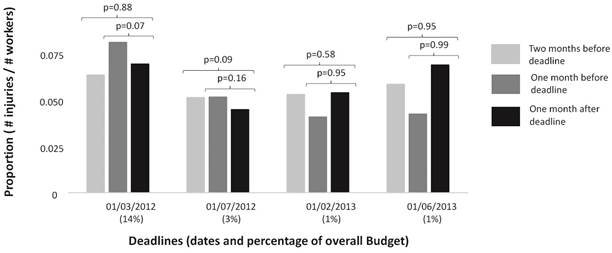Introduction
Time is the least studied variable in occupational injuries, except for cases such as natural disasters, where before-after analysis is mandatory1. Some previous studies have been associated with a greater occurrence of injuries at the first working days of the week regardless of culture. In the US, Sundays and Mondays are the days with a higher incidence of occupational injuries, especially among men workers2, whereas in Iran the higher occurrences are on Saturdays (first workday in this country) and Sundays3. In China, the higher incidences of fatal injuries occur on Mondays and in July and August4. In Australia and Spain between 14:00 and 16:00 and between 13:00 and 17:00, respectively, are the hours with more occupational fatalities, suggesting a “lunch effect” (5.
These few findings contrast with several studies that have explored the association between the occurrence of health outcomes and specific dates. Mortality and acute morbidity could change their occurrence on a daily, weekly or another temporal basis when social events are celebrated. For instance, mortality increases just after New Year’s Day, Thanksgiving, Christmas, and individuals’ birthdays6. In Sweden, the day before starting tax derogations mortality decreases7, whereas in Taiwan during the “ghost month” (~August) the occurrence of unintentional drowning deaths is lower than in other months8. A sociocultural epidemiology study in Mexico reported overall mortality increased during Christmas Day and All Saints’ Day, and during Candlemas Day among women, and New Year’s New Year’s Day among men9. To watch stressful soccer matches have been associated with higher incidences of acute cardiovascular events among German fans10, and acute alcohol intoxication increase on the day prior public holidays and special social events among Australians11. Suicide is more frequent in New Year´s Day, Mother’s Day, Mexican Independence Day, and Christmas among Mexicans12. Unfortunately, this type of findings is not consistent around the world, which suggests a specific sociocultural effect in each context.
One possible explanation of some of these associations is related to the economic incentives provided by certain dates6. For this reason, deadlines for completing contractual obligations with a company may become triggers that increase the occurrence of occupational injuries, as is the case with other outcomes. In the area of project management, “student syndrome” explains the human behavior of working at different intensities during the work process, with a relatively slow (regulated) pace the majority of the time while leaving most of the activities until last minute, just before the deadline13. Psychology calls this procrastination14, which suggests that it is a phenomenon with sociocultural roots and is inherent to individuals. In this analysis we explored the potential association between contractual obligations and increase in the occurrence of occupational injuries.
Material and methods
To explore this hypothesis, we analyzed injury records and consolidated monthly payroll reports (from January 2012 to September 2013) for personnel operations who worked in five companies that were involved in a megaproject to build a road in a highly mountainous region in Colombia. This project included a main tunnel of 8.6 km long, 24 secondary tunnels, 24 bridges, and complementary works. This secondary data analysis was approved by the School of Medicine and Health Sciences of the Universidad del Rosario, Bogotá, Colombia. Since our hypothesis that occur during the month after deadline < occurrence before the deadline, we used one-tailed binomial tests to compare the occurrence of injuries one and two months before and one month after four deadlines. Numerators used were the crude occurrence of occupational injuries, and the total of workers in each month were denominators. The contract goals were to be met in March and July of 2012 and February and June of 2013, corresponding to 14, 3, 1 and 1% of the overall budget, respectively.
Results
Three hundred forty-two injuries occurred during the study period. The most frequent injuries were falls, hits with objects and entrapments of upper limbs among construction assistants, operators and drivers. (Figure 1) presents the results of the analysis, which shows the highest occurrence of injuries during the month before the deadline corresponding to 14% of the budget. No significant differences were observed in other deadlines.
Discussion
These findings suggest that injuries increase significantly prior to important financial contractual milestone. The necessity to perform more activities leads to the involvement of more workers, with a corresponding increase in work hours and overtime. This phenomenon at work process appears to act as a trigger that increases the incidence of occupational injuries. Thus, important contractual milestones could increase human errors because in previous periods the job demands are higher than in other moments. Note that contractual milestones act as distal determinant whereas human errors are proximal determinants of injuries15. The “student syndrome” as effect contextual seems to be present in construction companies, becoming the macro expression of the procrastination of those responsible for organizing construction activities. Maybe, this may increase the labor stress of workers, which would lead to increased insecure acts and injuries. These findings show that it is important for construction companies to plan better the timelines of their activities so that they do not find themselves needing to increase unsafe work before important contractual deadlines.















